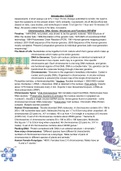Lecture notes
BS5101 Molecular Biology and Genetics Notes
- Institution
- University Of East London (UEL)
A comprehensive overview of the fundamental principles and concepts of molecular biology and genetics. Covers a wide range of topics, including DNA structure and replication, gene expression and regulation, protein synthesis, genetic variation and inheritance, and molecular genetics techniques. Th...
[Show more]



